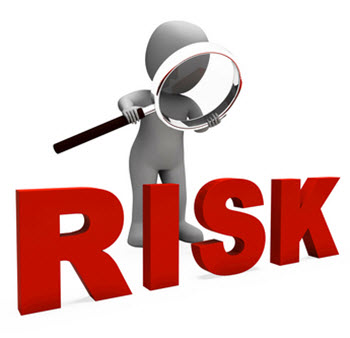With PRINCE2, a Risk Register plots the impact and probability of identified risks. The data is presented in a table and as a scatterplot.
The Risk Register is utilized as a risk management tool. In some contexts, it can be a vital aspect of fulfilling regulatory compliance for a project.
 Examples of information that goes into the Risk Register:
Examples of information that goes into the Risk Register:
- Identified risks
- Nature of each identified risk
- A brief description of the risk, unless the name of the risk is sufficient
- Probability/likelihood of occurrence, expressed on an integer scale
- Impact/consequence of the event occurring, expressed on an integer scale
- Risk score/risk rating. Commonly asssessed by multiplying Probability with Impact. Can be used to rank the risks.
- Mitigation steps
- An identification number for each risk
- Trigger, if applicable. (Example: The risk is flooding. The trigger is sudden major snow melting event due to warm weather.)
The risks are grouped together in categories, with each category comprised of similar risk types.
The risk registry is extra important in industries that involves a lot of risks. A good example of this is FOREX and Binary options trading. The traders are operating in a high-risk environment and need to consider the risk of every trade they make. Learn more about Binary options risk management. Learning more about risk management among binary options traders and poker players can teach you a lot about risk management in general and make you a better project manager.
Example
This is what a Risk Register in table format could look like for a celebration on a boat.
| Category | Name | RBS ID | Probability | Impact | Mitigation | Contingency | Risk Score after Mitigation | Action By | Action When |
| Nature | Too windy | 1.1 | Medium | High | Check weather forecast | Return to sheltered port | 2 | Captain | 25 knots |
| Nature | Rain | 1.2 | Medium | High | Make sure the roof is in good condition | Keep celebration under the roof | 2 | Peter | When rain clouds become visible |
| Nature | Fire onboard | 1.3 | Low | High | No open flames allowed | Use fire extinguishers | 1 | Everyone | Immediately |
| Guests | The guests find the party boring | 2.1. | Low | Medium | Have party games prepared | Play party games | 1 | Amanda | Within 1 hour |
| Guests | Sea sickness | 2.2 | Medium | Medium | Warn guests in advace of the risk | Bring OTC medication for sea sickness | 1 | John | When guest is in distress |
| Drinks | Running out of drinks | 3.1 | Low | Medium | Keep extra supplies below deck | Buy more at port | 1 | Javier | When <3 drinks are left for each guest |
| Drinks | Running out of ice | 3.2 | Medium | Medium | Keep extra in a large cool bag | Buy more at port | 1 | Javier | When <2 ice bags are left, if >2 hours are left of the party |
Common mitigation steps
- Identify
- Analyze
- Plan response
- Monitor
- Control
